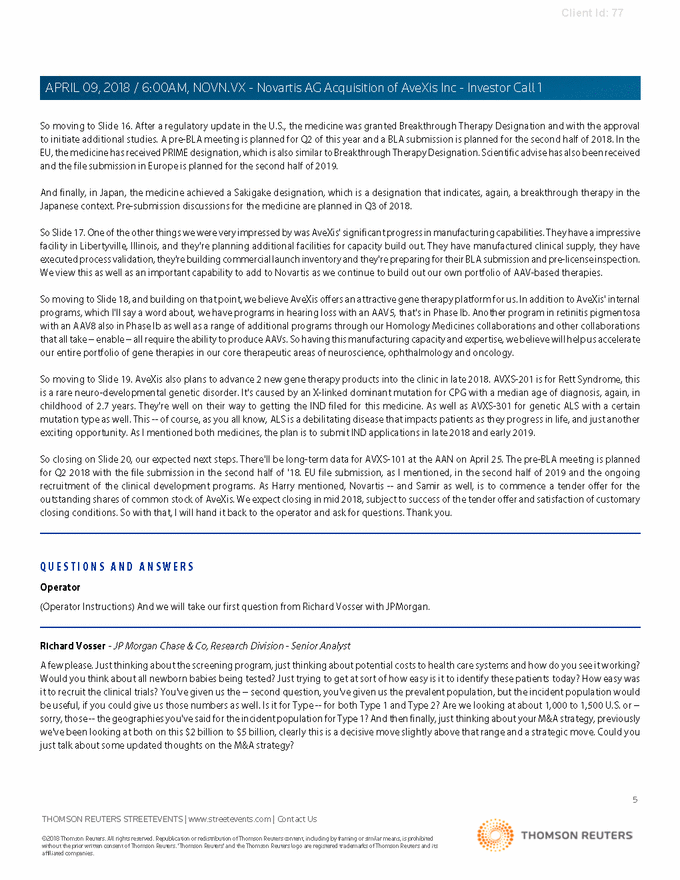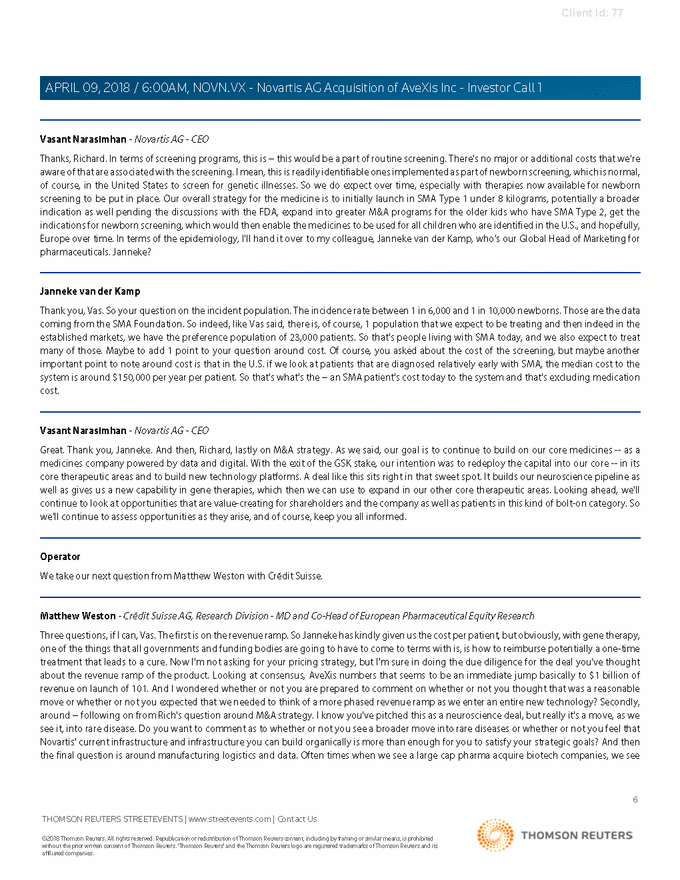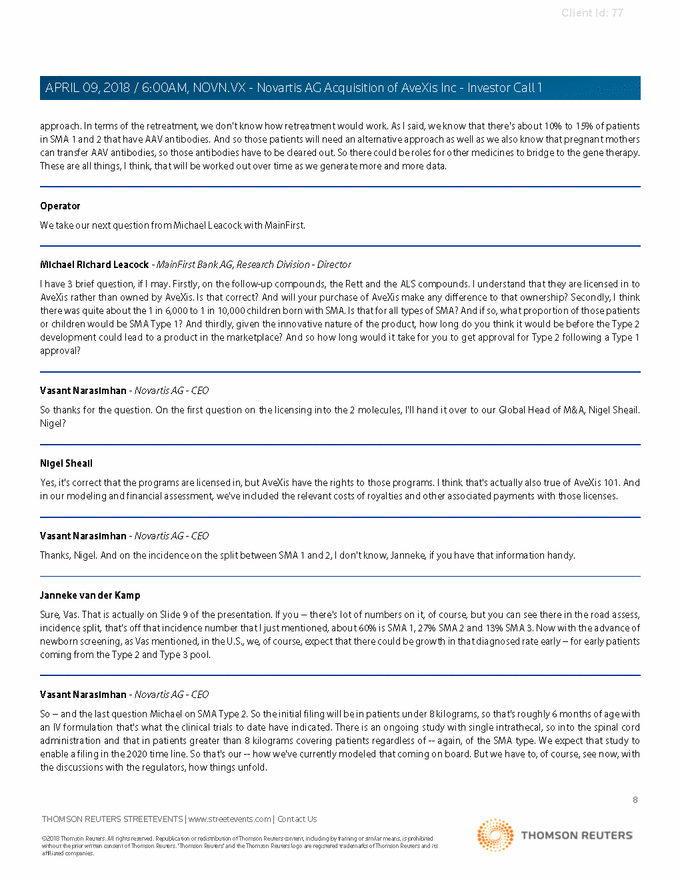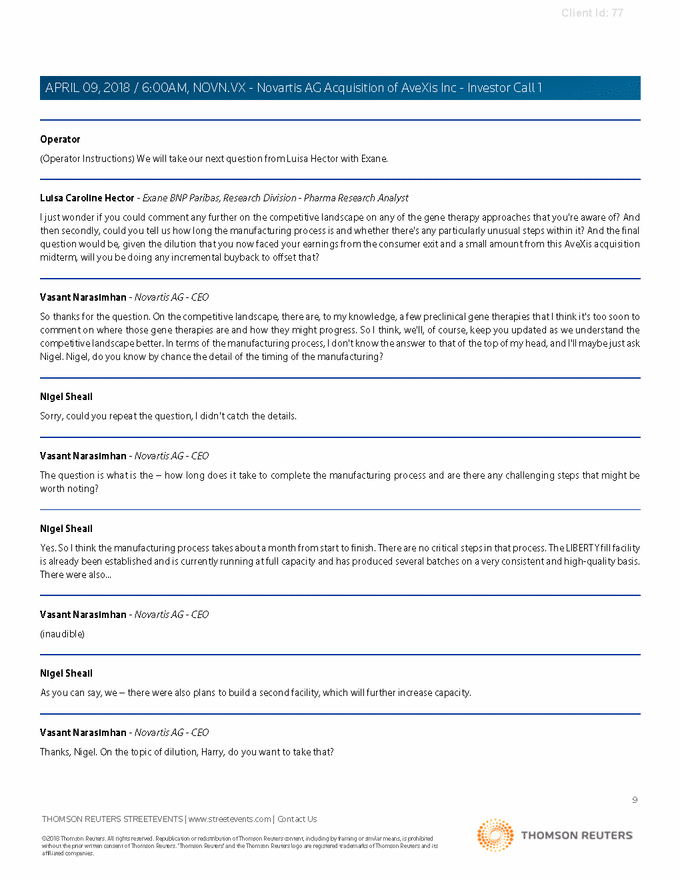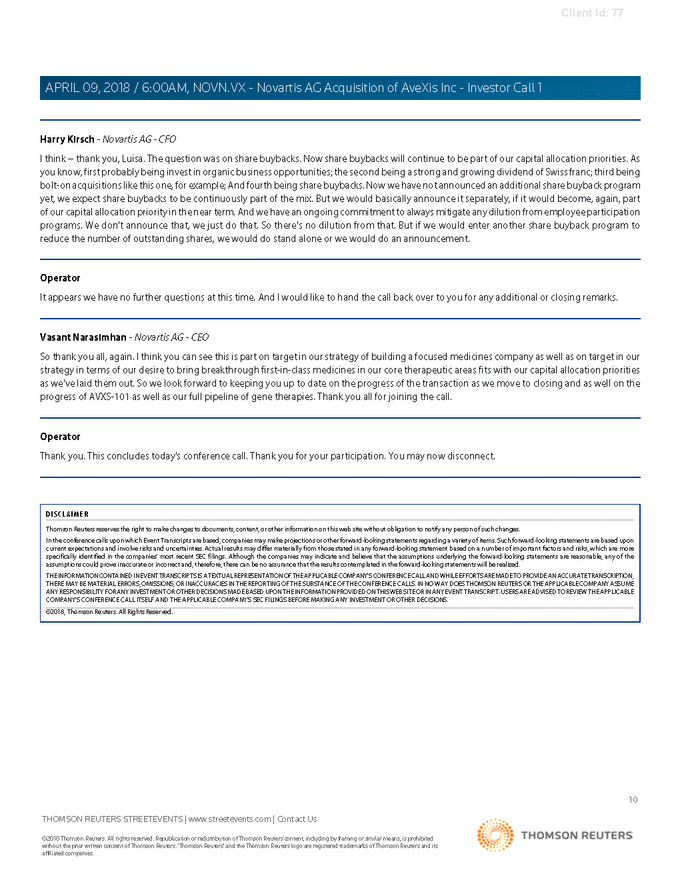Client Id: 77 APRIL 09, 2018 / 6:00AM, NOVN.VX - Novartis AG Acquisition of AveXis Inc - Investor Call 1 that they have to revisit data whether it would be around manufacturing infrastructure, regulatory requirements, and it's whether in your due diligence, your confidence that in this case you can meet the relatively rapid filing and approval goals that are baked into the market? Vasant Narasimhan - Novartis AG - CEO Thanks, Matthew, I appreciate the questions. First on revenue ramp. What we've guided to in our announcement, there is a significant revenue ramp from 2020 forward. In my view when you look at the situation with SMA, the currently marketed medicine is already reimbursed across the United States by private insurers and by Medicaid as well as almost all major European markets. So in this case, given the severity of this disease and the desire to help these patients, payers have already made the decision to invest. And when you look at the amount they're investing over time for the existing medication, it's quite significant already. So we believe, in this case, that decision has already been taken. And I believe over time, the issue here is not payer, payers appreciate that when you deliver a potentially curative therapy that takes out cost out of their health care system and enable people to live, hopefully, a more normal life, they are willing to pay and the key is the value. Our goal will be to take an approach on pricing that's focused on value, so value-based pricing, ensuring we're cost effective, ensuring we have appropriate programs in place to enable access. But again, in this case, we think that the road work has been in --put in place and now we can hopefully with the closure of this deal be able to bring AveXis forward across those markets. In terms of M&A strategy, the way we look at it in certain areas such as neuroscience and ophthalmology, there will be a pivot to rare diseases and gene therapies. We believe the monogenic, genetic disorders, potentially polygenic disorders can be addressed with gene therapies, that's why we made the move with Luxturna to license Luxturna outside the United States for ophthalmology, that's why we made the move here. We believe the science is very profitable, the efficacy is quite significant. So when I think about rare diseases, I try to put it in the lens of, is this in a therapeutic area where we already have a significant presence that we can leverage in both neuroscience, ophthalmology, you can argue with pediatric ALL, and CART, and oncology. These are rare diseases, those diseases that fit into our therapeutic profile. We have a lot of capability in this given our work with Ilaris. Ilaris, of course, is treating CAPS in hereditary periodic fever disorders, has been incredibly successful as well as Sandostatin in some of our rare drugs in oncology. So we have this rare disease capability as well. But I would say, we would assess each opportunity with the lens of, is it a technology that we're interested in? Does it fit in our therapeutic areas to do things and generate value for Novartis patients and our shareholders. And lastly, in terms of manufacturing logistics, we've done a very careful due diligence. We believe the company has done a great job in terms of its work on validating its batches and validating its process, gearing up and being ready for FDA inspection. So we feel comfortable based on all we've seen and where we are. And I think, given our experience in Morris Plains with our CART therapy, we have a pretty good understanding of what it take to get through an FDA inspection for one of these medicines. Operator We take our next question from Michael Leuchten with UBS. Michael Leuchten - UBS Investment Bank, Research Division - Co-Head of Pharmaceuticals Research of Equity Research It's Mike Leuchten from UBS. Two clinical questions, please. One, is your view that the direct administration of the transgene trumps the splicing approach or can you comment on potential combination given you have branaplam in Phase I/II testing in your own pipeline? And then secondly, have you --did you have any view as to whether there is potential for retreatment with the AAV9? And I'm thinking about antibodies here that might deny the ability to do that. Vasant Narasimhan - Novartis AG - CEO Thank you, Michael. In terms of the potential for complementarity, I mean, I think, our view is that this therapy will become the front-line therapy, because of its ability to address the underlying basis of the disease. And then, of course, the patients and parents will have to determine and as well as clinical data --as well as the physicians, most importantly, as well as the clinical data how additional therapies could be used to further augment the patient's overall functioning. We view our current internal oral drug LMI, which is quite early, really it's something that's complementary to this kind of a gene-based approach for patients. The approximate 10% to 15% of patients that have AAV antibodies, alternative therapies are going to be required. And so I think, having something like our LMI molecule will be complementary to what we have here with the gene-based 7 THOMSON REUTERS STREETEVENTS | www.streetevents.com | Contact Us ©2018 Thomson Reuters. All rights reserved. Republication or redistribution of Thomson Reuters content, including by framing or similar means, is prohibited without the prior written consent of Thomson Reuters. 'Thomson Reuters' and the Thomson Reuters logo are registered trademarks of Thomson Reuters and its affiliated companies.





